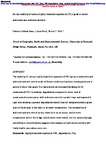On the stability of various highly branched isoprenoid (HBI) lipids in stored sediments and sediment extracts
| dc.contributor.author | Cabedo Sanz, P | |
| dc.contributor.author | Smik, L | |
| dc.contributor.author | Belt, Simon | |
| dc.date.accessioned | 2016-11-18T15:13:55Z | |
| dc.date.issued | 2016-07 | |
| dc.identifier.issn | 0146-6380 | |
| dc.identifier.other | C | |
| dc.identifier.uri | http://hdl.handle.net/10026.1/6762 | |
| dc.description | publisher: Elsevier articletitle: On the stability of various highly branched isoprenoid (HBI) lipids in stored sediments and sediment extracts journaltitle: Organic Geochemistry articlelink: http://dx.doi.org/10.1016/j.orggeochem.2016.04.010 content_type: article copyright: © 2016 Elsevier Ltd. All rights reserved. | |
| dc.description.abstract |
The stability of various highly branched isoprenoid (HBI) lipids in sediments and sediment extracts stored under different conditions has been investigated over a period of about two years. Our data reveal an increased tendency for tri-unsaturated HBIs to undergo degradation compared to mono- and di-unsaturated counterparts, with sediments stored in plastic bags and exposed to light also showing a greater degradation extent than for samples stored in glass vials or those kept in the dark or at lower temperature. The composition of sediment extracts stored as dry material or as solutions, and at room temperature and in a refrigerator, exhibited no clear trends, but the extremely high variability in concentrations suggests that analysis of such stored extracts will likely lead to anomalous results. | |
| dc.format.extent | 74-77 | |
| dc.language | en | |
| dc.language.iso | en | |
| dc.publisher | Elsevier BV | |
| dc.subject | Highly branched isoprenoid | |
| dc.subject | HBI | |
| dc.subject | Degradation | |
| dc.subject | IP25 | |
| dc.title | On the stability of various highly branched isoprenoid (HBI) lipids in stored sediments and sediment extracts | |
| dc.type | journal-article | |
| dc.type | Journal Article | |
| plymouth.author-url | https://www.webofscience.com/api/gateway?GWVersion=2&SrcApp=PARTNER_APP&SrcAuth=LinksAMR&KeyUT=WOS:000376532900008&DestLinkType=FullRecord&DestApp=ALL_WOS&UsrCustomerID=11bb513d99f797142bcfeffcc58ea008 | |
| plymouth.volume | 97 | |
| plymouth.publication-status | Published | |
| plymouth.journal | Organic Geochemistry | |
| dc.identifier.doi | 10.1016/j.orggeochem.2016.04.010 | |
| plymouth.organisational-group | /Plymouth | |
| plymouth.organisational-group | /Plymouth/Faculty of Science and Engineering | |
| plymouth.organisational-group | /Plymouth/Faculty of Science and Engineering/School of Geography, Earth and Environmental Sciences | |
| plymouth.organisational-group | /Plymouth/REF 2021 Researchers by UoA | |
| plymouth.organisational-group | /Plymouth/REF 2021 Researchers by UoA/UoA07 Earth Systems and Environmental Sciences | |
| plymouth.organisational-group | /Plymouth/Research Groups | |
| plymouth.organisational-group | /Plymouth/Research Groups/Marine Institute | |
| plymouth.organisational-group | /Plymouth/Users by role | |
| plymouth.organisational-group | /Plymouth/Users by role/Academics | |
| plymouth.organisational-group | /Plymouth/Users by role/Researchers in ResearchFish submission | |
| dcterms.dateAccepted | 2016-04-22 | |
| dc.rights.embargodate | 2017-10-30 | |
| dc.rights.embargoperiod | Not known | |
| rioxxterms.versionofrecord | 10.1016/j.orggeochem.2016.04.010 | |
| rioxxterms.licenseref.uri | http://www.rioxx.net/licenses/all-rights-reserved | |
| rioxxterms.licenseref.startdate | 2016-07 | |
| rioxxterms.type | Journal Article/Review |


